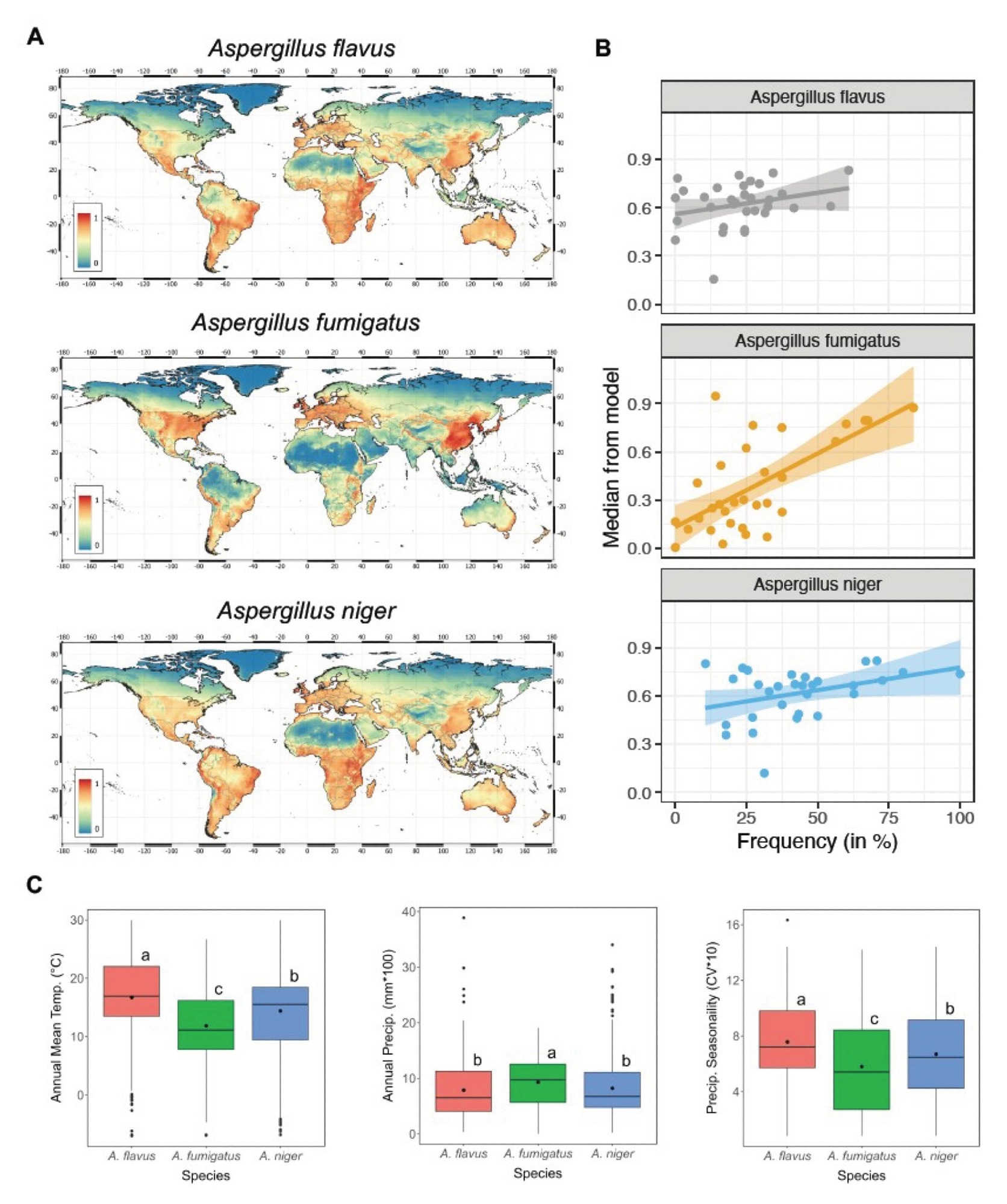Table of Contents
As global temperatures rise, new research reveals that Aspergillus species are on the move, reshaping the landscape of infectious disease and threatening the world’s food supply in unexpected ways.
 Research: Climate change-driven geographical shifts in Aspergillus species habitat and the implications for plant and human health. Image Credit: CI Photos / Shutterstock
Research: Climate change-driven geographical shifts in Aspergillus species habitat and the implications for plant and human health. Image Credit: CI Photos / Shutterstock

 *Important notice: Research Square publishes preliminary scientific reports that are not peer-reviewed and, therefore, should not be regarded as conclusive, guide clinical practice/health-related behavior, or treated as established information.
*Important notice: Research Square publishes preliminary scientific reports that are not peer-reviewed and, therefore, should not be regarded as conclusive, guide clinical practice/health-related behavior, or treated as established information.
In a recent preprint* study posted to the Research Square server, a team of researchers modelled the current and future global distribution of Aspergillus fumigatus, Aspergillus flavus, and Aspergillus niger under different climate scenarios and assess their implications for human disease and crop exposure.
Background
Fungal spores from Aspergillus species are present everywhere— in soil, air, and even our homes. Each day, people inhale hundreds of these microscopic spores. While most are harmless to healthy individuals, they can cause life-threatening infections in people with weakened immune systems and substantial agricultural losses due to crop contamination. Aspergillus fumigatus, Aspergillus flavus, and Aspergillus niger are among the most common culprits behind these health and economic impacts. Rising global temperatures may alter their suitable habitat range, potentially increasing exposure risks in new regions. This study aims to provide a clearer picture of how climate change could transform their distribution and amplify their threats.
About the study
Researchers collected global fungal occurrence data from the GlobalFungi database (release 5.0), focusing on three species: Aspergillus fumigatus, Aspergillus flavus, and Aspergillus niger. Only soil samples with more than ten sequencing reads per species were retained to ensure accuracy. Environmental data were extracted from WorldClim and included seven key bioclimatic variables: Annual Mean Temperature, Mean Diurnal Range, Temperature Annual Range, Annual Precipitation, Precipitation of Driest Month, Precipitation Seasonality, and Precipitation of Coldest Quarter. Future projections were based on the Sixth Coupled Model Intercomparison Project, specifically using the Hadley Centre Global Environment Model (HadGEM3-GC31-LL) under three Shared Socioeconomic Pathways—SSP126 (low emissions), SSP245 (moderate), and SSP585 (severe)—for three time periods (2041–2060, 2061–2080, and 2081–2100).
Species distribution modeling was performed using the Maximum Entropy (MaxEnt) algorithm, with data split into training and test sets (75%/25%). Model accuracy was evaluated using Receiver Operating Characteristic curves and Area Under the Curve values. Thresholds for suitable habitats were established using the Maximum Test Sensitivity Plus Specificity method. Human population data from a 1 km resolution database and global crop growing areas (CROPGRIDS) were overlaid to assess human and agricultural exposure. A literature review was also conducted to correlate clinical prevalence with environmental suitability. The authors acknowledge that the MaxEnt modelling approach has limitations, such as its reliance on presence-only data, potential for sampling bias, and the fact that it does not account for factors like genetic adaptation of the fungi or microenvironmental variability; therefore, the results indicate relative habitat suitability.
Study results
The MaxEnt model successfully predicted the current and future global distribution of Aspergillus fumigatus, Aspergillus flavus, and Aspergillus niger. Present-day suitability maps showed Aspergillus fumigatus favoring temperate regions in the Northern Hemisphere, while Aspergillus flavus and Aspergillus niger were more prevalent in warmer, tropical climates. Validation with 29 soil studies demonstrated a strong correlation between predicted environmental suitability and actual fungal presence.
Future climate scenarios revealed northward shifts in suitable habitats for all three species. Under the severe warming scenario (SSP585), the habitat of Aspergillus flavus will diminish across Africa, South America, and Oceania but expand into Russia, China, and North America. Aspergillus fumigatus suitable habitat will retreat from the Southern Hemisphere and tropical zones, concentrating in cooler northern areas like Scandinavia and Alaska. Aspergillus niger will retain its broad range but show inland losses of suitable habitat in Africa.
The implications for crop infections were also striking. Using MaxEnt and crop distribution data, researchers showed that suitable habitats for Aspergillus flavus and Aspergillus niger will shrink across the top global crops, including maize, rice, and wheat. For maize, habitat overlap with Aspergillus flavus is projected to decline from 19.1 million km² today to just 6.8 million km² by 2090. For rice, the suitable area will fall from 8.8 million km² to 2.0 million km². Aspergillus niger will also see reductions, but less severe than Aspergillus flavus.
In clinical terms, the prevalence of Aspergillus species in human infections correlated strongly with environmental distribution. Countries with dominant environmental presence of a species also reported higher clinical incidence in invasive aspergillosis. Population exposure models revealed that currently 1.98 billion people live in areas suitable for Aspergillus fumigatus, 905 million for Aspergillus niger, and 846 million for Aspergillus flavus. These numbers are expected to decrease overall under climate change, with significant reductions in Asia, Africa, and South America—but potential increases in population exposure in some areas, such as for A. niger in parts of Europe and for A. flavus in Australia, according to the study’s projections.
Dr. Norman van Rhijn, lead author of the study from the University of Manchester, commented on the broader implications, stating, “We’ve already seen the emergence of the fungus Candida auris due to rising temperatures, but, until now, we had little information of how other fungi might respond to this change in the environment. Fungal pathogens will likely impact most areas of the world in the future.” He further elaborated that, while such specific figures are not detailed as direct outputs in this preprint, interpretations of the model under a scenario of continued fossil fuel reliance (SSP585) could suggest that the changing suitable habitat for Aspergillus flavus might effectively translate to an exposure increase for an additional 1 million more people in Europe, and for Aspergillus fumigatus, this could mean 9 million additional people potentially exposed in the region.

MaxENT model accurate described Aspergillus global distributions. A Habitat suitability for three Aspergillus species from the MaxENT model. Least suitable is 0 and most suitable is 1. B Correlation plots of frequency of each Aspergillus species found in the literature compared to the median suitability for that particular country in the MaxENT model. C Boxplots showing environmental differences between A. flavus, A. fumigatus and A. niger among three environmental variables used for SDM. Species marked with the same letter are not significantly different at P
Conclusions
To summarize, this study underscores the impact of climate change on the shifting global distribution of key Aspergillus species that threaten both public health and agriculture. The Maximum Entropy model revealed northward movement of suitable habitats, particularly under severe warming scenarios, and linked these shifts to changes in clinical and environmental fungal prevalence. Aspergillus flavus is poised to lose substantial crop habitat in the tropics, while Aspergillus fumigatus becomes more dominant in cooler regions. These trends could reshape disease burden and food security globally. Early surveillance, climate-adapted healthcare planning, and agricultural strategies, while considering the inherent limitations of such predictive models, will be essential to reduce the risks posed by these fungi.

 *Important notice: Research Square publishes preliminary scientific reports that are not peer-reviewed and, therefore, should not be regarded as conclusive, guide clinical practice/health-related behavior, or treated as established information.
*Important notice: Research Square publishes preliminary scientific reports that are not peer-reviewed and, therefore, should not be regarded as conclusive, guide clinical practice/health-related behavior, or treated as established information.
Journal reference:
- Preliminary scientific report.
Norman van Rhijn, Christopher Uzzell, Jennifer Shelton et al. Climate change-driven geographical shifts in Aspergillus species habitat and the implications for plant and human health, Research Square (2025). DOI: 10.21203/rs.3.rs-6545782/v1, https://www.researchsquare.com/article/rs-6545782/v1


